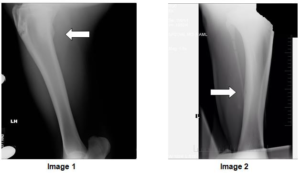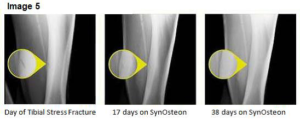Introduction to Tibial Stress Fractures
Tibial stress fractures frequently occur in young racehorses but can also appear in older horses getting back into training after a long period of rest. Although they can happen at most any training phase, these types of fractures typically occur during developmental training or retraining between 3/8 and 5/8 mile works,. They are usually acute and very painful for the horse, and require time out of training to heal.
Tibial stress fractures occur as a result of repeated stress cycling of the bone during training. These bending forces are necessary for the bone to remodel and become strong enough to endure the stress forces produced during maximal exercise. The problem arises when remodeling is unable to keep pace with stress cycling which leads to stress fatigue and eventually to fracture.
There are a number of factors that influence the development of tibial stress fracture; the horse’s body condition, track surface, training regimen and diet. There is experimental and theoretical evidence suggesting that long gallops, while building aerobic conditioning, can put excessive stress on the long bones during developmental training. Jogging, progressively increasing gallops, and short works at speed must be balanced in the early phases of the racehorse training.
Incidences of tibial stress fractures have decreased over the past 20 years as most trainers have learned to modify their training patterns. Yet, they do continue to be a significant cause of injury. They are especially frustrating when they occur after a horse is returning to training after a period of extended rest. Even though the prognosis for complete healing and a return to racing is excellent, the time needed to recover is significant and usually occurs just as the horse is ready to race. This time away from training can be costly and will require the horse to work even harder in order to become fit enough to race again.
Diagnosing Tibial Stress Fractures
Tibial stress fracture is suspected any time a young horse becomes acutely lame on a hindlimb without some other obvious source noted upon physical examination. Because the tibia is such a large bone and mostly covered by muscle, it is difficult to diagnose simply by physical examination. As shown in the images, radiographs usually demonstrate callus formation (Image 1) or a cortical fracture (Image 2).

In cases where a stress fracture is suspected but not seen radiographically, nuclear scintigraphy (bone scan) may be necessary (Images 3, 4). The use of nerve blocks is not a feasible option for diagnosis this high on the limb.

Managing Tibial Stress Fractures
Traditional treatment for tibial stress fractures is 90-120 days out of training. Modern approaches are more specific and also dependent on the severity of the bone lesion. The presence of a cortical fracture and the severity of periosteal reaction and callus are the primary factors used to determine the rehabilitation protocol.
Horses with mild to moderate periosteal reaction/callus formation usually need very little time out of training. A typical effective management plan would be:
- Hand walk the horse until it is sound at the jog (approximately two weeks).
- Walk the horse for another week.
- Walk under tack for an additional two weeks.
- Return to jogging for two weeks.
- Reintroduce gallops and resume fitness training.
Horses with a more severe periosteal reaction/ callus may require more time for initial soundness.
Horses with cortical fractures will require an additional amount of time away from training. Without effective supplementation this could take 90-120 days of rest. Once the fracture is healed and no longer visible radiographically, the horse may start jogging under tack and resume fitness training.
These are the basic guidelines and are often modified to fit the individual horse along with other factors. Image 5 is an example of a case managed with SynOsteon supplementation.

Preventing and Supplementing for Tibial Stress Fractures
Regardless of the severity of the injury, treatment of tibial stress fractures primarily requires rest and closely managed training during rehabilitation. In fact, nearly all horses will heal with rest alone. Extracorporeal shock wave therapy and Tildren TM have been used to decrease healing time with questionable results. There are serious concerns regarding long term bone health when treating with bisphosphonates (drug class including Tildren TM). Recently, a new nutraceutical product, SynOsteon TM, has been successfully used to decrease healing time with tibial stress fractures. This is most obvious in the case of cortical fractures.
SynOsteon TM is a proprietary blend of herbal and endogenous nutrients designed to promote healthy bone metabolism. Along with the nutrient components of bone, it contains multiple osteoclast inhibitors as well as osteoblast stimulators. In the author’s opinion, SynOsteon TM is, to date, the most effective preventive and treatment modality available.
Even the best designed and managed horse training protocol will not prevent all tibial stress fractures. However, throughout one racing season, stables that supplemented with SynOsteon TM from the time horses began training, and continuing through racing fitness, have not reported new stress fractures of any kind.

